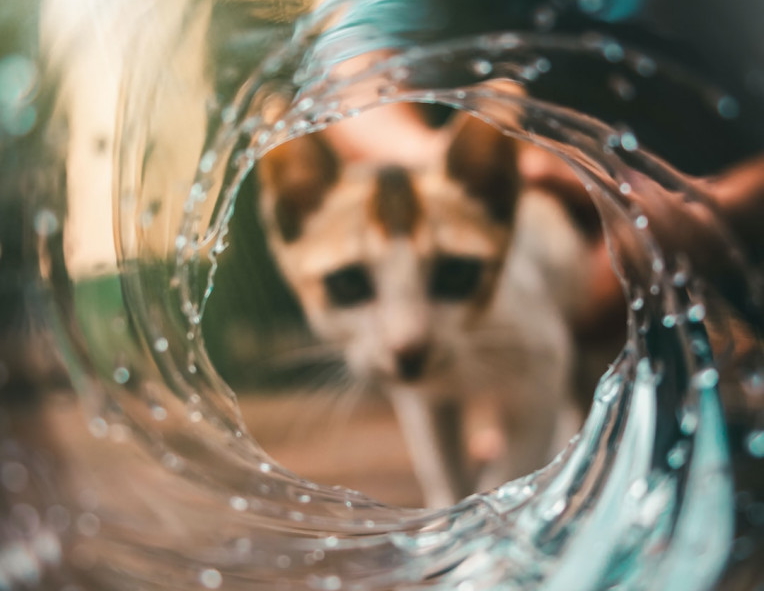
Hello, Cat Enthusiasts!
Today I’d like to talk about chronic dehydration in cats.
In this article, we are going to discuss causes and consequences of chronic dehydration and strategies to increase water intake.
Chronic Dehydration in Cats
Cats are predisposed to low water intake that leads to chronic mild dehydration. Chronic dehydration is particularly dangerous as often it is not accompanied by noticeable symptoms until progressive systemic diseases develop and it becomes life-threatening.
Water Metabolism in Cats
Water is one of the most important nutrients. Water is a part of every cell in the body, it makes up approximately 70% of the body weight in young cats and about 50% in senior cats. It serves many functions, such as transport of nutrients, thermoregulation, digestion and elimination of toxins. Water supports cellular structure and provides biochemical reactions.
Water balance is affected by age, diet, health conditions, environmental conditions and physical activity. Healthy cats self-regulate water balance through osmoregulatory mechanisms. Cats have a low thirst drive and a well-developed excretory system that is able to significantly concentrate urine to minimize water loss. These mechanisms help cats survive without water on natural diet but also make them susceptible to dehydration.
There are three main sources of water for cats: food, free water and metabolic water (i.e., small amount of water produced when other nutrients are metabolized). In cats on natural or wet diets, most of the water is absorbed from the food. On the other hand, cats on dry diets need to drink plenty of free water as commercial dry diets contain only 10% of moisture. Regardless of their diet, healthy adult cats need on average 50-70 ml of total water per 1 kg of body weight to maintain optimal health.
How Does Chronic Dehydration Develop?
There are two types of dehydration: severe and chronic dehydration. Severe dehydration is a life-threatening medical condition that causes clear symptoms, such as increased heart rate, loss of appetite, sunken eyes, lethargy, and require immediate professional medical treatment. On the other hand, chronic low-level dehydration is much easier to miss as it develops slowly, sometimes during the whole life of a cat, and often comes without acute symptoms for a long time.
In healthy cats, chronic dehydration is often caused by diet, which doesn’t contain optimal amount of moisture, such as dehydrated or dry cat food. Cats prefer to consume fluid with their food and have a low thirst drive. In addition, cats are unable to drink large amounts of water due to the anatomical characteristics. Cats who eat exclusively (or mostly) dry food are likely to develop chronic dehydration as they constantly receive less water than needed to compensate the lack of moisture in their food. Furthermore, chronic dehydration has a snowball effect as slightly dehydrated cats tend to be even less sensitive to thirst.
Negative Effects of Chronic Dehydration
Chronic dehydration is a dangerous condition that primarily affects urinary system, over time causes irreversible damage to internal organs and ultimately leads to terminal diseases.
Health problems associated with chronic dehydration include:
Feline lower urinary tract disease (FLUTD)
Chronic kidney disease (CKD)
Digestive disorders
Dental diseases
Obesity
Cardiovascular disease
Neurological disorders
Degenerative joint conditions
How to Increase Water Intake?
To prevent chronic dehydration and further health problems, it’s important to understand individual drinking preferences of your cat. Try different strategies and observe your cat’s behaviour to find suitable method.
- Keep multiple water bowls throughout the house
- Get a cat drinking fountain
- Include wet food in your cat’s diet
- Use nutrient-enriched water
- Use lactose-free milk, cat-milk
- Add water to food
Final Thoughts
Cats who eat dry food are vulnerable to chronic dehydration. They have to drink large amounts of water to maintain water balance. There are several options to encourage cats drink more water. Change your cat’s diet gradually to avoid gastrointestinal problems and never force your cat to drink. If you have any concerns, always consult with your veterinarian.
If you have something to add or wish to share your experience, please leave a comment.
Thank You For Reading!
